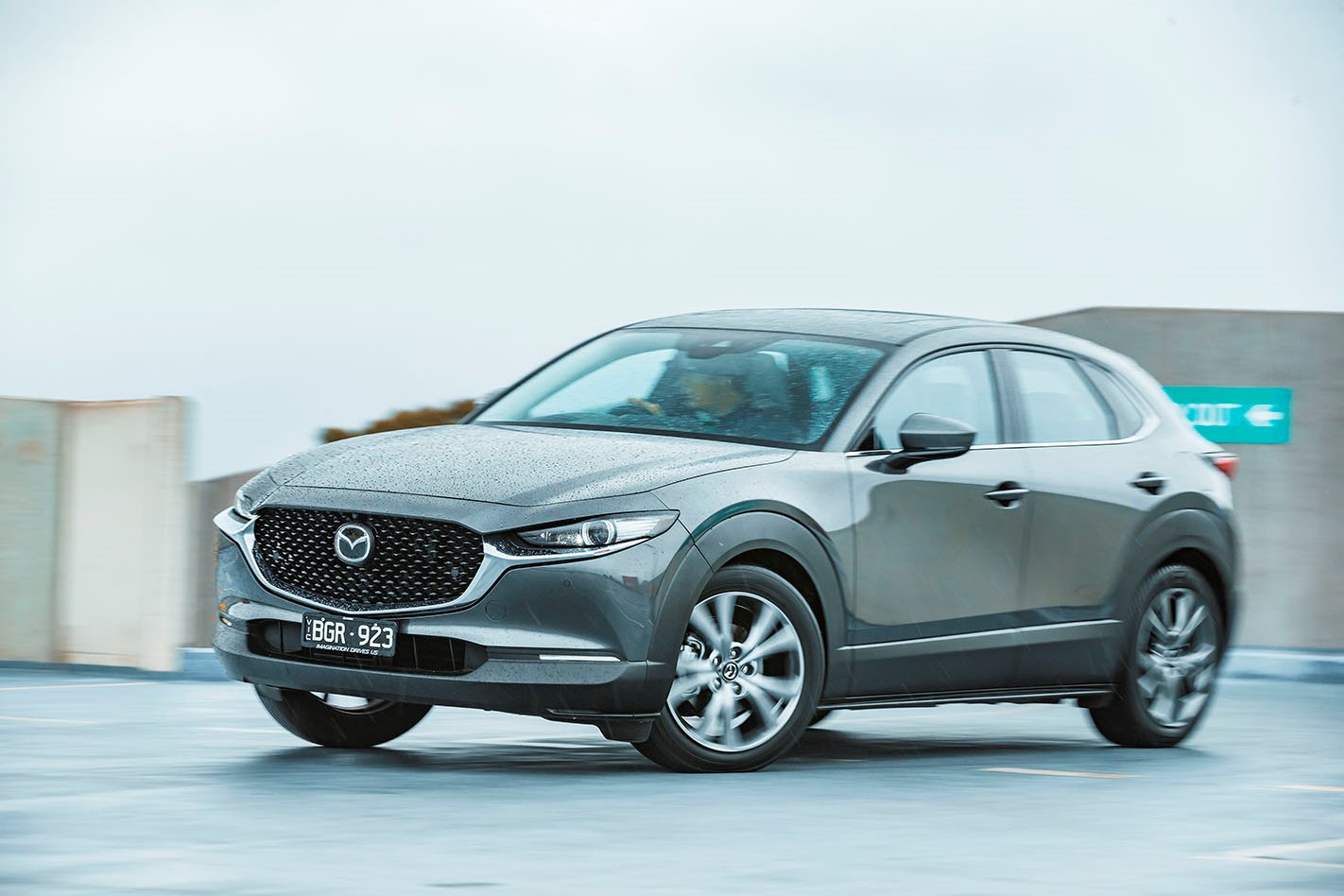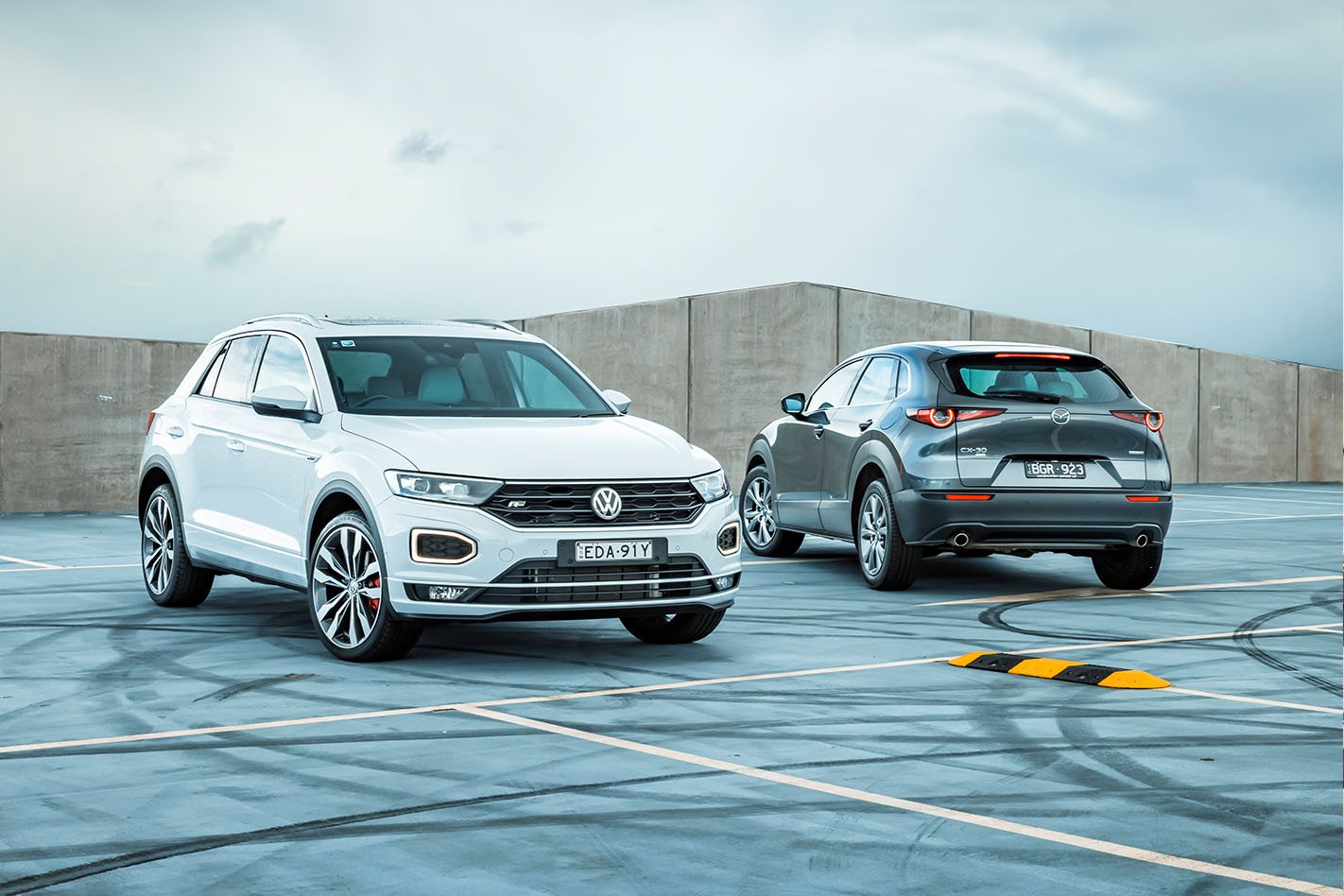What we have here, dressed as two mid-sized SUVs, is a conundrum. Where do your priorities lie when it comes to choosing a set of wheels? Do you want soothing practicality and a vehicle that does its job with ease while leaving you in sublime comfort? Or are you searching for something more athletic that aims to be more than just a conveyance and appeals to the heart as much as the mind? In other words, do you prefer the tortoise or the hare?
Our contenders for this philosophical dilemma are the Volkswagen T-Roc and Mazda CX-30. The VW is a fashionably late newbie to the segment, while the Mazda has already cemented itself as the class benchmark by winning multiple Wheels tests.
Not to be confused with its smaller T-Cross sibling, the T-Roc takes what makes the Golf a perennial favourite, and applies its hatch ethos to the small-ish SUV game. It’s actually 21mm shorter than the Golf Mk7.5, but some 20mm wider. It’s also more compact than the Mazda which is 149mm longer than the T-Roc and has an extra 60mm between its axles.
International sales for the T-Roc started three years ago after the vehicle was revealed to the world at Geneva in 2014, but gobsmacking global demand has left Volkswagen’s local arm waiting patiently to enter the lucrative small-SUV segment.
The range-topping 140TSI Sport that we have on test starts at an agreeable $40,490, but as-tested here it costs $46,590 before on-roads. Both the Luxury Package ($3500), and Sound and Style Package ($2000) are included on our test vehicle, while metallic paint adds $600.
These option packs are needed to get the T-Roc on par with the CX-30 in the gizmo arms war. Opting for the Luxury Pack brings heated front seats, a panoramic sunroof, electric tailgate, and seats trimmed in a combination of real and artificial leather. The Sound and Style Package adds adaptive dampers, 19-inch alloy wheels, and a 300-watt Beats sound system.
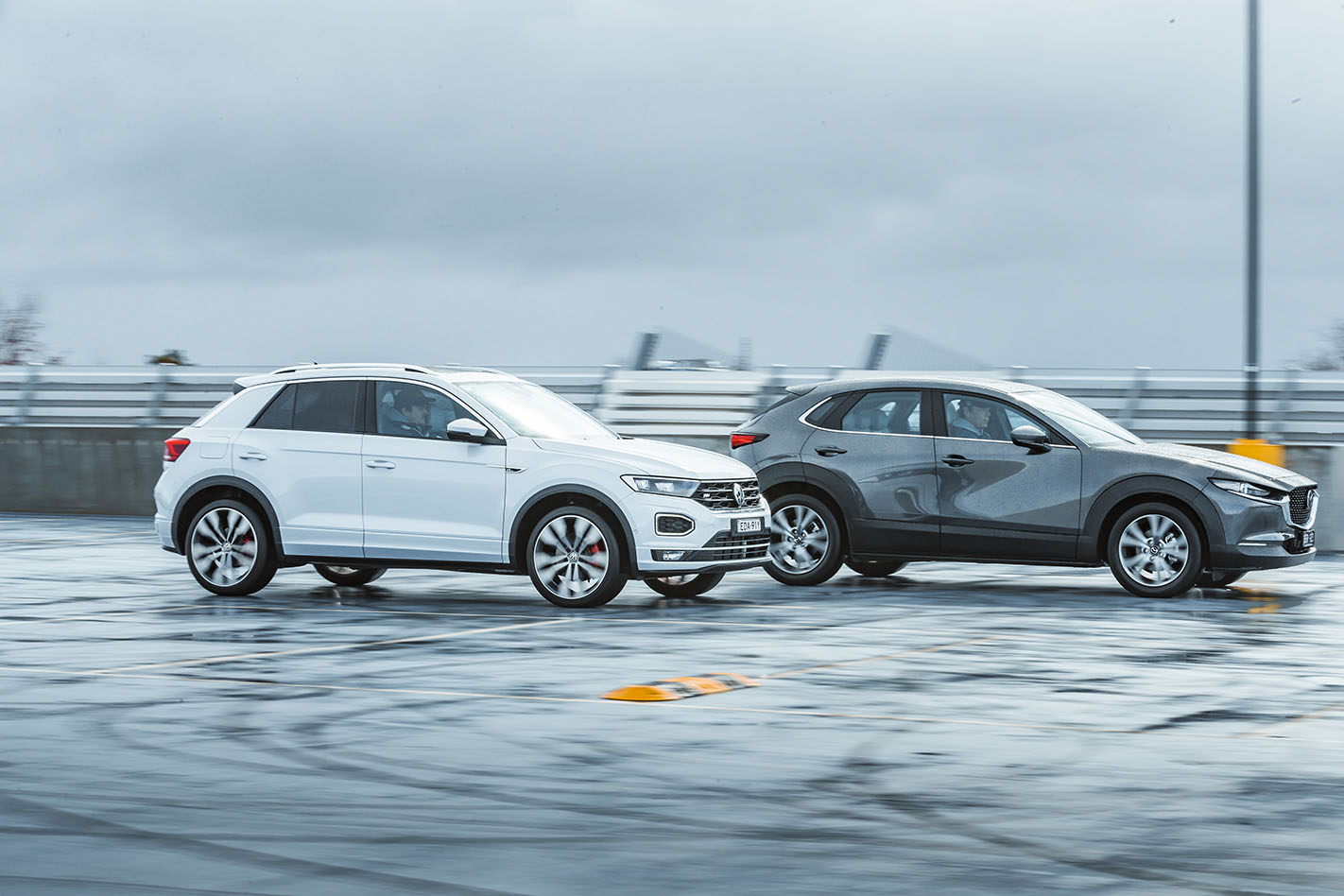
The CX-30 gracing these pages is the $43,490 G25 Astina flagship, with options limited to metallic paint ($495) and front floor mats ($195) for an as-tested price of $44,180.
Standard equipment is generous, with a glass sunroof, 18-inch alloys, 12-speaker Bose sound system, 360-degree parking camera, front cross traffic alert, heated front seats and steering wheel, head-up display, electric tailgate, and ultra-soft leather.
Not only is the Mazda better appointed on-paper as standard, but the material quality feels classes above that offered by VW. Where the German interior is all hard plastic and pleather, the Japanese have skinned half of Rockhampton’s bovine stock to lay over the dash, door trims, centre console, steering wheel and seats.
And despite being an almost $50K SUV, the VW has no electric seat adjustment, nor a head-up display or 360-degree parking monitor. All small omissions, but together they add up to an interior that can only dream of one day being as well-equipped and luxurious as the Mazda.
Both of these SUVs are handsome in their own right and neither forgo functionality for style. While they each have a coupe-like silhouette with a sloped roof, both provide decent rear headroom. Adults taller than six foot can sit comfortably in the rear of both… just. There isn’t much in it, but the T-Roc is more suitable for people-moving duties, with theatre-style seating in the second row and no rising beltline hampering outward vision. Mazda hits back with doors that open wider (almost to 90 degrees) and plusher, more comfortable seating.
In the inanimate hauling stakes the T-Roc wins again with its 392-litre boot holding a 75-litre advantage over the CX-30. The tailgate of the VW opens taller than the Mazda, and reveals a lower loading lip to haul gear over. The T-Roc has 40:20:40 split rear seats, while the Mazda makes do with a simple 60:40 split. The most obvious ergonomic foible of either vehicle is in the T-Roc, where it’s all-too easy to bash your shin on the lower part of the dash when entering the front seats.
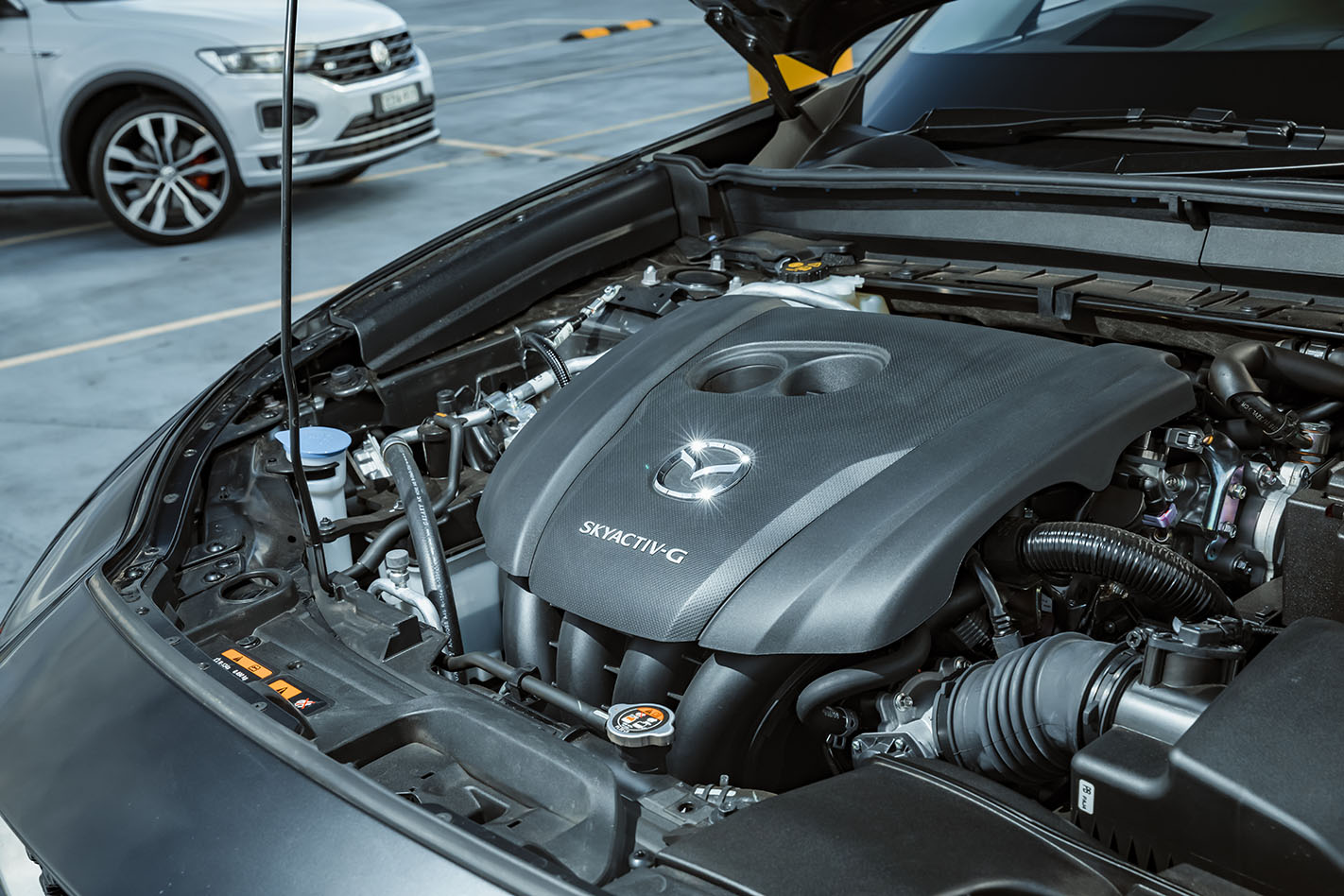
The T-Roc fires its most potent salvo at the Mazda from under the bonnet, where it packs a 2.0-litre turbocharged four-cylinder engine producing a punchy 140kW and 320Nm. The T-Roc never feels stressed with the peak power figure available between 4900-6000rpm, while the hearty shove of peak torque is spread from 1500-4800rpm. Mated to a seven-speed dual-clutch shifts are slick, with VW vanquishing the DCT hesitation that plagued older models.
Readers of this website should be well acquainted with the Skyactiv-G 2.5-litre in the CX-30. It’s just about the antithesis of VW’s EA888 unit, requiring a decent serving of revs to get into the powerband. Peak power of 139kW doesn’t arrive until 6000rpm, and torque shove maxes out at 252Nm at 4000rpm. If you aren’t in a rush it’s all rather amenable, and the six-speed torque converter auto is happiest when throttle inputs are progressive.
The VW’s turbo engine shames the Mazda in the real-world. Both off the line and in overtaking manoeuvres, the T-Roc offers instant go. Meanwhile the CX-30 requires considered inputs to prevent droning revs, and greater room when trying for an overtake.
While both models on test are all-wheel drive, not all drivetrains are made equal, and the Volkswagen’s Haldex-based 4motion system is the clearly superior option. In low-grip conditions, the Mazda all too readily spun the inside front tyre out of tight bends accompanied by a frantically flashing traction control light. The VW easily applied its superior power outputs, with all four wheels doing their part to maintain traction in challenging conditions. As you exit a bend and wind off lock, you can apply an aggressive throttle input and the system will deliver as much power as possible to the ground with little fuss or bother.
On our test the Volkswagen has the advantage of optional adaptive dampers, giving it a duality of character that can fulfil both the everyday commute and weekend warrior duties. In comfort mode it’s bested only marginally by the Mazda, which combines top-notch noise suppression that VW can’t match with a ride quality that absorbs bumps ever so slightly better. It’s a lineball difference between the pair on highway duties, with the Mazda’s quieter cabin eking it an advantage.
Take the exit ramp to a winding backroad, and the VW shines. The steering weight in the T-Roc is well judged and very Golf-like, with a direct 2.2 turns lock-to-lock. Meanwhile the Mazda’s helm feels a touch too light and lacks any great feel and feedback with a lazier 2.8 turns lock-to-lock. Body control is superior in the T-Roc, which settles nicely in the bends, while the CX-30 pitches and rolls more noticeably. The brake pedal is much softer in the Mazda compared to the T-Roc, which at first seems over-servoed but provides greater feel.

In its sportier modes the VW comes alive, with a genuinely engaging character. You’d happily punt it down your favourite B-road, though in this setting you do sacrifice some ride refinement when encountering larger bumps and potholes.
By comparison, the Mazda never thrills you as a driver and is best suited to someone that prefers a direct route to the road less travelled. Put simply, the T-Roc is more enjoyable at every point of the cornering process and its superior engine will get you to the next bend faster.
That said, the Mazda is one of the most polished SUVs to be released this year and the local arm is having no trouble in selling CX-30s in reasonable quantities. It’s the best-appointed contender in the class, with specification to rival cars almost double the price. On long drives it’s calming and quiet, with well-judged ride refinement, and superior noise suppression. Thing is, there’s no passion in the way it drives. If all you ever want in life is to drive A-to-B in leather-lined, syrupy-riding comfort, then the CX-30 remains a great choice and is one of the most convincing small SUVs on sale.
However, its ride and cabin quality advantage isn’t enough to overcome the unavoidable fact the Volkswagen is the more engaging drive. If you have just an ounce of fuel in your veins, it really is the obvious choice here. And if you’ve ever swiped the keys off the table with the intention to just drive with no destination, letting the road work its catharsis on you, then the T-Roc is the clear winner.
But, is that what you want from your small-ish SUV? As-tested (and how the vehicle should be specced to get the most return), the T-Roc is almost the same price as a Golf GTI. For many, the pleasant luxury of the CX-30 will be all they ever desire.
It’s a tortoise-versus-hare choice, this one, but in our race the late-arriving T-Roc edges past the CX-30 in a photo finish.
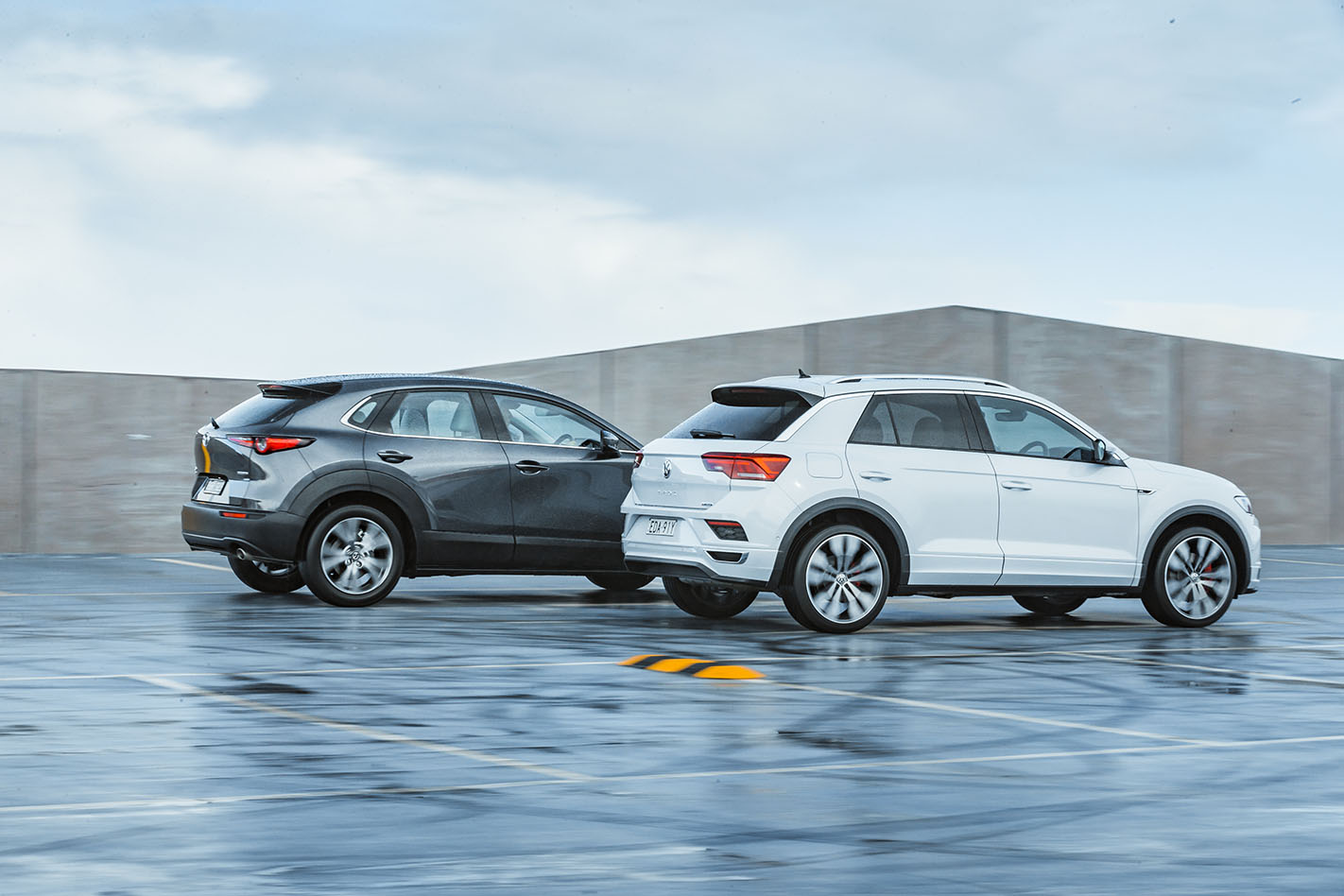
HOW DOES THE INFOTAINMENT COMPARE?
It’s a case of ‘Look, but don’t touch’ in the Mazda. The 8.8-inch screen is moved out of reach, but higher on the dash for safety. The latest version of MZ Connect adds smartphone mirroring.
The T-Roc’s 8.0-inch screen is smaller than that found in current Golf, but comes with all the bells and whistles. Graphics are slick, menus are easy to navigate, and has benefit of touchscreen
WHAT ABOUT THE REAR SEATS?
Both rear seats are comfortable for tall adults thanks to clever cut-outs in the fronts. Legroom difference is minimal, but vision outward is superior in the VW.
THE RIVAL – KIA SELTOS GT-LINE ($41,100)
The Kia Seltos makes most sense in its cheaper model grades, but the range-topping GT-Line ceratinly offers lots of kit. Its 130kW/265Nm 1.6-litre turbo can’t match the T-Roc’s punch, but you do get the benefit of a seven-year warranty. You also score all-wheel drive, seven-speed DCT, and multi-link suspension instead of the base Seltos’s atmo engine, front-drive layout, CVT gearbox and torsion-beam rear-end. The interior can’t hold a candle to Mazda’s exquisite execution but, in truth, nothing else does at this price point.

VOLKSWAGEN T-ROC 140TSI SPORT SPECS
Engine: 1984cc 4cyl, dohc, 16v, turbo
Max power: 140kw @4900-6000rpm
Max torque: 320Nm @ 1500-4800rpm
Transmission: 7-speed dual-clutch
L/W/H/WB: 4246/1819/1572/2595mm
Weight: 1495kg
0-100km/h: 7.2sec (claimed)
Economy: 7.2L/100km
Price: $40,490
On sale: Now
Plus: Punchy engine; genuinely beneficial all-wheel drive; engaging dynamic ability; great outward vision
Minus: Needs options to be at its best; some interior materials sub-par; noise suppression can’t match Mazda
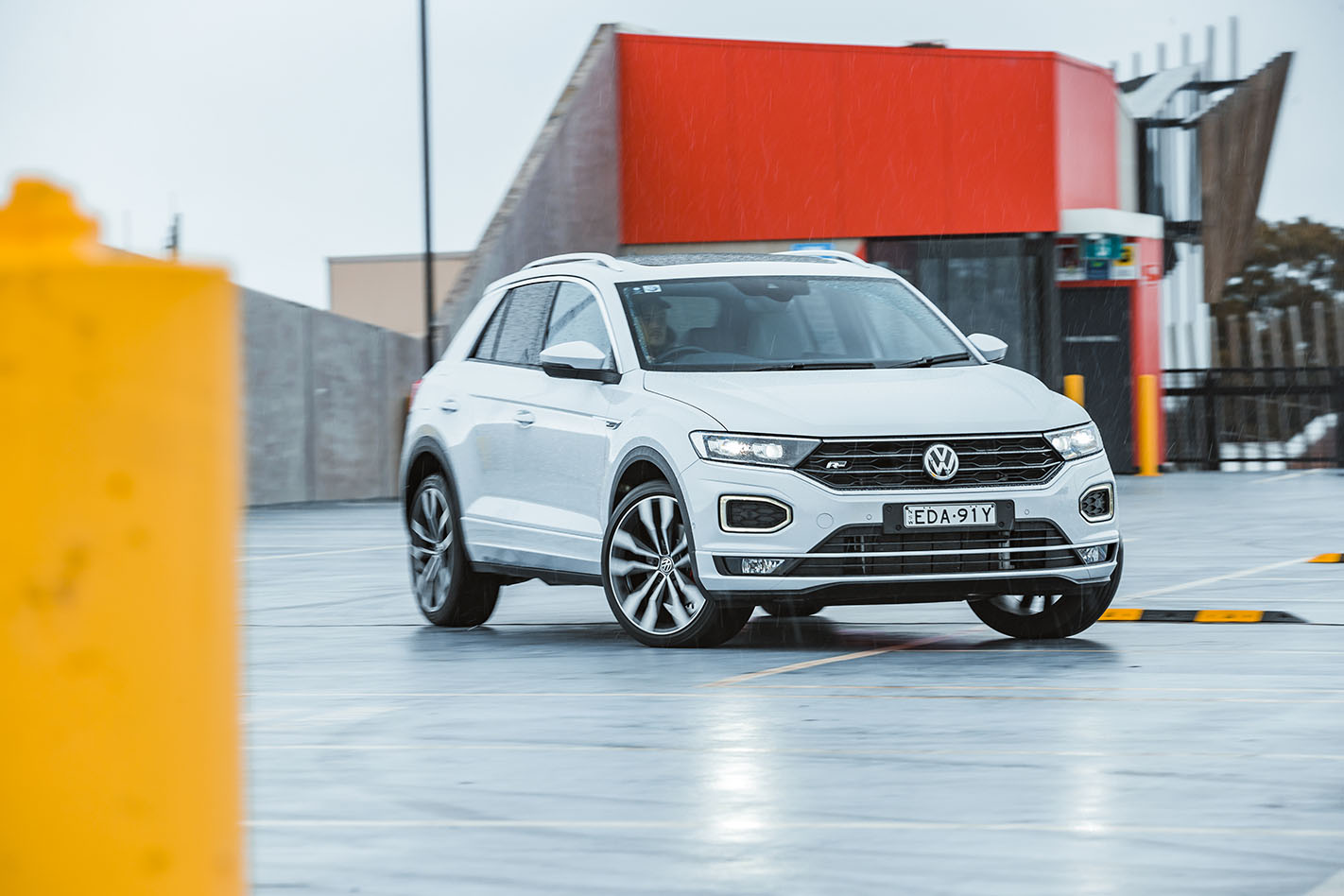
MAZDA CX-30 G25 ASTINA SPECS
Engine: 2488cc 4cyl, dohc, 16v
Max power: 139kW @ 6000rpm
Max torque: 252Nm @ 4000rpm
Transmission: 6-speed automatic
L/W/H/WB: 4395/1795/1540/2655mm
Weight: 1442kg
0-100km/h: 9.1sec (claimed)
Economy: 6.8L/100km
Price: $43,490
On sale: Now
Plus: Interior materials are seriously lux; generous standard equipment; calming and refined ride quality
Minus: Asthmatic atmo engine; doesn’t offer any driving thrill; all-wheel-drive system easily becomes flustered
